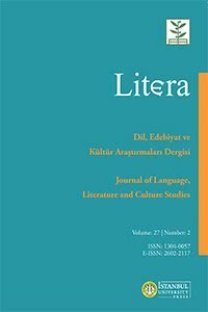Türkiye’de Hamlet Çevirileri Tarihi
Bu çalışma Osmanlı İmparatorluğunun 1880’lü yıllarda Batı kültürü ve Shakespeare’e gösterdiği ilginin sonucu olarak yapılan Hamlet çevirilerine kısaca değindikten sonra oyunun modern ve çağdaş çevirilerini derinlemesine incelemeyi amaçlamaktadır. Çeviri ediminin bir metni erek dilde yeniden yazma ya da uyarlama çabası olması nedeniyle, bu çözümleme yalnızca Shakespeare’in Türkler tarafından nasıl algılandığını değil, aynı zamanda dil, edebiyat ve çeviri anlayışının yıllar içerisinde nasıl dönüştüğünü de gözler önüne serer. Halide Edib, Can Yücel ve Özdemir Nutku gibi akademisyen ve çevirmenlerin yaptığı ya da yönettiği çevirilerin yakın okuma yöntemiyle incelenmesiyle söz konusu çevirilerin erek okur/izleyicilerindeki farklılıkların ortaya çıkartılması hedeflenmekedir. Bir çevirinin skopos, amaç ve dolayısıyla stratejisi büyük ölçüde erek okur ya da alıcıya dayandığı için bu tartışmaya başlamadan önce her bir çevirinin erek okurunu/izleyicisini tanımlamak büyük önem taşımaktadır. Ayrıca, Türkiye’deki Hamlet çevirilerinin tarihsel incelenmesi sürecinde çevirmenin amaç ve stratejilerinin yanısıra Türk dili ve kültürünün on dokuzuncu yüzyıldan bu yana geçirdiği değişim de büyük rol oynamaktadır. Bu bağlamda bu çalışma, çevirilerin yakın okuma yöntemiyle incelenmesi sonucun-da Hamlet’in kültürler arası gerçekleştirdiği bu zaman yolculuğunu çözümlerken Popovič’in deyiş kaydırması adını verdiği değişikliklerden örnekler de sunmaktadır.
History of Hamlet Translations in Turkey
Starting with a brief discussion of the first Hamlet translations in accordance with the Ottoman interest in western culture and Shakespeare in the 1880s, this study intends to present an in depth historical analysis of the modern and contemporary translations of the play. Since the act of translation is an attempt to rewrite and/or adapt a given text in the target language and culture, this analysis does not only portray the way Shakespeare is perceived by the Turks but also gives evidence to the changing nature of the Turkish culture and its understanding of language, literature, and translation throughout the years. With the close reading of translations made or conducted by academicians and translators such as Halide Edib, Can Yücel and Özdemir Nutku, this study aims at displaying the differences between these translations’ target audiences/readers. Since the skopos, purpose and hence, strategy of a given translation is utterly dependant on the target audience, defining the target audience of each translation is a significant starting point. Furthermore, apart from the differences in the translators’s purpose and strategy, the changes the Turkish language and culture experienced since the nineteenth century play a crucial role in presenting a historical discussion of Hamlet translations in Turkey. In this respect, while examining Hamlet’s inter-temporal and inter-cultural journey in Turkey, through a close reading of translations, this paper also presents various examples of shifts of expression in Popovič’s terms.
Keywords:
Hamlet, Shakespeare, Hamlet in Turkey, translation history shift of expression,
___
Ayluçtarhan, S. (2007). Dr. Abdullah Cevdet’s Translations (1908-1910): The Making of a Westernist and Materialist ‘Culture Repertoire’ in a ‘Resistant’ Ottoman Context, MA Thesis. Boğaziçi University, Istanbul.Bozkurt, B. (2013). Hamlet’i Türkçe’ye Çevirirken, W. Shakespeare, Hamlet (pp. 17-21) (B. Bozkurt, Trans.). Istanbul: Remzi Kitabevi.
Das Gupta, J. (1968). Language Diversity and National Development, J. A. Fishman, C. A. Ferguson, J. Das Gupta (Eds.). Language Problems of Developing Nations (pp. 17-28). New York & London: John Wiley & Sons, Inc.
Enginün, İ. (1979). Türk Edebiyatında Shakespeare: Tanzimat devrinde tercüme ve tesiri. Istanbul: Dergah Yayınları.
Even-Zohar, I. (1990). The Position of Translated Literature within the Literary Polysystem, Poetics Today11 (1), Durham, NC: Duke University Press, 45-51.
Kott, J. (1967). Shakespeare our Contemporary (B. Taborski, Trans.). London: Methuen & Co Ltd.Lomax, A. & Halifax, J. (2000). Folk Song Texts as Culture Indicators. A. Lomax (Ed.). Folk Song and Culture (pp. 274-299). New Brunswick & London: Transaction Publishers.
Nida, E. (2000). Principles of Correspondence, L. Venuti (Ed.). The Translation Studies Reader (pp. 126-141). London: Routledge.
Paker, S. (1986). “‘Hamlet’ in Turkey”, New Comparison: A Journal of Comperative and General Literary Studies, 2(Autumn), Norwich: University of East Anglia, 89-105.
Paker, S. (1991). “Turkey”, R. Ostle (Ed.). Modern Literature in the Near and Middle East 1850-1970 (pp. 17-32). New York: Routledge.
Shakespeare, W. (1941). Hamlet: Danimarka Prensi (H. Edib & V. Turhan, Trans.). Istanbul: Istanbul Cumhuriyet Matbaası. (1603)
Shakespeare, W. (1946). Hamlet (O. Burian, Trans.). Istanbul: Milli Eğitim Basımevi. (1603)
Shakespeare, W. (1992). Hamlet (C. Yücel, Trans.). Istanbul: Adam Yayınları (1603)
Shakespeare, W. (1995). Hamlet (S. Eyüboğlu, Trans.). Istanbul: Remzi Kitabevi. (1603)
Shakespeare, W. (1997). Hamlet (H. Jenkins, Ed.). Surrey: Thomas Nelson & Sons (1603)
Shakespeare, W. (2013a). Hamlet (B. Bozkurt, Trans.). Istanbul: Remzi Kitabevi. (1603)
Shakespeare, W. (2013b). Hamlet (Ö. Nutku, Trans.). Istanbul: Mitos Boyut. (1603)
Turhan, V. (1965). “Shakespeare in Turkish”, Litera Vol.8, Istanbul: Istanbul University Press, 49-61.
- Yayın Aralığı: Yılda 2 Sayı
- Yayıncı: İstanbul Üniversitesi
Sayıdaki Diğer Makaleler
Nora-Bir Bebek Evi’ne Feminist Bir Yorum
Düşsel ve Gerçek Arasında Doğu’da Seyahat’i Okumak
Traveler Writer, Romanesque Traveler: A Travel Literature Phenomenon
Türkiye’de Hamlet Çevirileri Tarihi
Mizahî Ögelerin Çevirisi Üzerine Bir İnceleme: Bir Noel Gecesi Örneği
Varoluşçu Özgürlük Bağlamında Kadın: Simone de Beauvoir ve İkinci Cinsiyet
Space and Intimate Immensity in Éric Emmanuel Schmitt’s Night of fire
Disguised Subjugation as Education: Colonial and Maternal Pedagogy in Jamaica Kincaid’s Lucy
